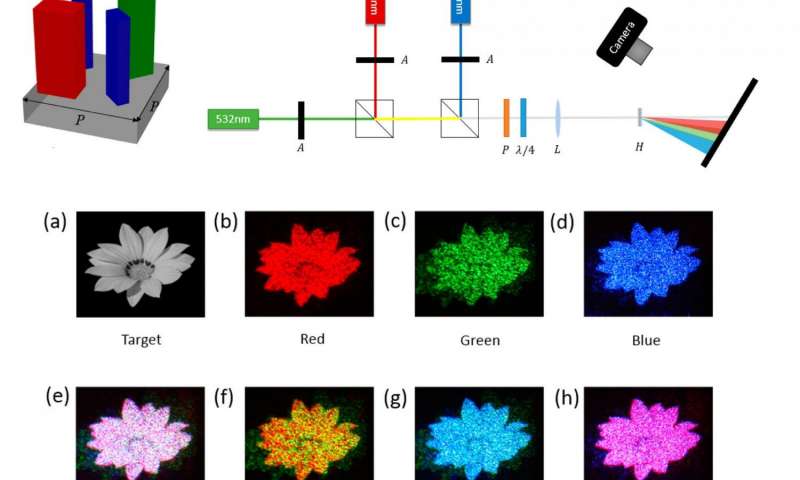Colour holograms enabled with metasurface made of nanoblocks
By carefully arranging many nanoblocks to form pixels on a metasurface, researchers have demonstrated that they can manipulate incoming visible light in just the right way to create a colour "meta-hologram." The method of creating holograms has an order of magnitude higher reconstruction efficiency than similar color meta-holograms, and has applications for various types of 3D colour holographic displays and achromatic planar lenses.
The researchers, Bo Wang et al., from Peking University and the National Center for Nanoscience and Technology, both in China, have published a paper on the new type of hologram in a recent issue of Nano Letters.
The pixels on the new metasurface consist of three types of silicon nanoblocks whose precise dimensions correspond to the wavelengths of three different colours: red, green, and blue. To enhance the efficiency for the blue light, two identical nanoblocks corresponding to the blue light are arranged in each pixel, along with one nanoblock for red light and one for green light.
The researchers explain that each pixel can be thought of as a "meta-molecule" because it is the basic repeating, subwavelength unit of the larger metasurface that constitutes the entire hologram. The meta-molecules enable the metasurface to control light in ways that are not possible without modern nanoscale design.
When red, green, and blue lasers illuminate the hologram, each nanoblock manipulates the phase of its corresponding colour. The researchers explain that a key achievement of the study was to minimise the interactions between nanoblocks so that the nanoblocks function almost independently of each other.
Then by orienting the nanoblocks in different ways, the researchers could change the light's phase manipulation, resulting in different holographic images.

(Top left) One pixel, which is made of four nanoblocks. (Top right) Experimental setup for generating a colour hologram. (Bottom) Experimental results of achromatic colour holograms, made of red, green, or blue light or by combining these colours. Credit: Wang et al. ©2016 American Chemical Society
The researchers demonstrated that the nanoblock approach can be used to create two different types of holograms. In an achromatic hologram, the entire reconstructed image is in one colour. By balancing the relative input of the three colours, a wide spectrum of colours can be achieved.
In the second type of hologram, called a highly dispersive hologram, different parts of the reconstructed image have different colours—for example, a red flower, green stem, and blue container.
The new colour hologram has a variety of potential applications where spectral wavefront manipulation is required, such as 3D colour holograms, achromatic lenses, and anti-conterfeiting planar optical devices. The researchers plan to pursue these applications in future work.





